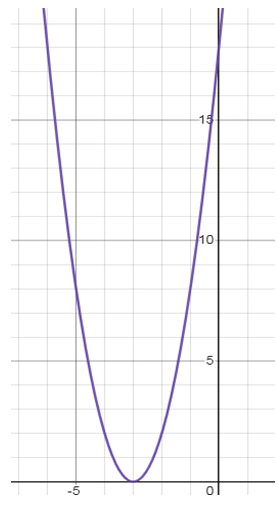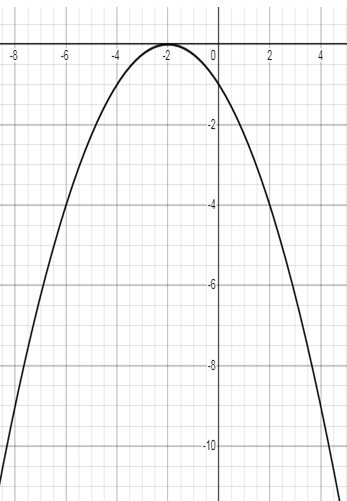SKETCH THE QUADRATIC FUNCTION WITH X INTERCEPTS
The graphical form of any quadratic function will be a parabola (the shape of U).
The quadratic equations which is in the form of
y = ax2 + bx + c
may be open upward parabola or open downward parabola.
Based on the sign of leading coefficient, we may decide the parabola opens up or down.
How to find x-intercept ?
By applying y = 0, we can find the x-intercept.
If the quadratic equation is having two distinct real roots, the parabola will pass through those different points on the x-axis.
Graph crosses x-axis twice

If the quadratic equation is having two same real roots, the parabola will intersect the x-axis once. (Multiplicity)
Graph crosses x-axis once

If the quadratic equation is having no real roots, the parabola will not intersect the x-axis.
Graph does not cross x-axis

Using axes intercepts only, sketch the graphs of:
Problem 1 :
y = (x - 4) (x + 2)
Solution :
y = (x - 4) (x + 2)
Equating each factor to zero, we get
x - 4 = 0 x + 2 = 0
x = 4 x = -2
So, the parabola will cross the x-axis at -2 and 4.
y = (x - 4) (x + 2) ==> x² -2x - 8
Considering the coefficient of x², the sign is positive. So, the parabola opens up.
y-intercept :
When x = 0, y = -8

Problem 2 :
y = -(x - 4)(x + 2)
Solution :
y = -(x - 4) (x + 2)
Equating each factor to zero, we get
x - 4 = 0 x + 2 = 0
x = 4 x = -2
So, the parabola will cross the x-axis at -2 and 4.
y = -(x - 4) (x + 2) ==> -x² +2x + 8
Considering the coefficient of x², the sign is negative. So, the parabola opens down.
y-intercept :
When x = 0, y = 8

Problem 3 :
y = 2(x + 3) (x + 5)
Solution :
y = 2(x + 3) (x + 5)
Equating each factor to zero, we get
x + 3 = 0 x + 5 = 0
x = -3 x = -5
So, the parabola will cross the x-axis at -3 and -5.
y = 2(x + 3) (x + 5) ==> 2x² +16x+30
Considering the coefficient of x², the sign is positive. So, the parabola opens up.
y-intercept :
When x = 0, y = 30

Problem 4 :
y = -3x(x + 4)
Solution :
y = -3x(x + 4)
Equating each factor to zero, we get
-3x = 0 x + 4 = 0
x = 0 x = -4
So, the parabola will cross the x-axis at 0 and -4
y = -3x(x + 4) ==> -3x² -12x
Considering the coefficient of x², the sign is negative. So, the parabola opens down.
y-intercept :
When x = 0, y = 0

Problem 5 :
y = 2(x + 3)²
Solution :
y = 2(x + 3)²
Equating each factor to zero, we get
2(x + 3)² = 0
x = -3
So, the parabola will touch the x-axis at -3.
Considering the coefficient of x², the sign is positive. So, the parabola opens up.
y-intercept :
When x = 0, y = 18

Problem 6 :
y = -1/4(x + 2)²
Solution :
y = -1/4(x + 2)²
Equating each factor to zero, we get
-1/4(x + 2)² = 0
x = -2
So, the parabola will touch the x-axis at -2.
Considering the coefficient of x², the sign is negative. So, the parabola opens down.
y-intercept :
When x = 0, y = -1

Recent Articles
-
Finding Range of Values Inequality Problems
May 21, 24 08:51 PM
Finding Range of Values Inequality Problems -
Solving Two Step Inequality Word Problems
May 21, 24 08:51 AM
Solving Two Step Inequality Word Problems -
Exponential Function Context and Data Modeling
May 20, 24 10:45 PM
Exponential Function Context and Data Modeling